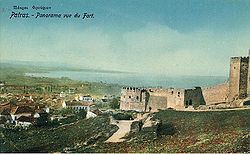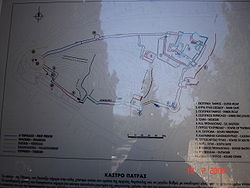
Patras Castle
Encyclopedia


Acropolis
Acropolis means "high city" in Greek, literally city on the extremity and is usually translated into English as Citadel . For purposes of defense, early people naturally chose elevated ground to build a new settlement, frequently a hill with precipitous sides...
, on a low outlying hill of the Panachaiko
Panachaiko
The Panachaikon or Panachaiko , also known as Vodias in medieval times and until the early 20th century, is a mountain range that spans about 20 km in length from north to south , and 15 to 20 km from east to west...
Mountain and ca. 800 m from the sea. The castle covers 22,725 m² and consists of a triangular outer wall, strengthened by towers and gates and further protected originally by a moat
Moat
A moat is a deep, broad ditch, either dry or filled with water, that surrounds a castle, other building or town, historically to provide it with a preliminary line of defence. In some places moats evolved into more extensive water defences, including natural or artificial lakes, dams and sluices...
, and an inner compound on the northeastern corner, also protected by a moat.
History
The castle was built by Byzantine emperor Justinian IJustinian I
Justinian I ; , ; 483– 13 or 14 November 565), commonly known as Justinian the Great, was Byzantine Emperor from 527 to 565. During his reign, Justinian sought to revive the Empire's greatness and reconquer the lost western half of the classical Roman Empire.One of the most important figures of...
after the catastrophic earthquake of 551, re-using building material from pre-Christian structures. One of these spolia
Spolia
Spolia is a modern art-historical term used to describe the re-use of earlier building material or decorative sculpture on new monuments...
, the torso and head of a marble Roman statue, became part of the city's folklore, a sort of genius loci
Genius loci
In classical Roman religion a genius loci was the protective spirit of a place. It was often depicted in religious iconography as a figure holding a Cornucopia, patera and/or a snake. There are many Roman altars found in Western Europe dedicated in whole or in part to the particular Genius Loci...
. It is known as the "Patrinella", a maiden who is supposed to have been transformed into a man during Ottoman times, guards the city against disease and weeps whenever a prominent citizen of Patras dies.
The fort remained in constant use thereafter, even until the Second World War. In the Byzantine
Byzantine Empire
The Byzantine Empire was the Eastern Roman Empire during the periods of Late Antiquity and the Middle Ages, centred on the capital of Constantinople. Known simply as the Roman Empire or Romania to its inhabitants and neighbours, the Empire was the direct continuation of the Ancient Roman State...
period, it was besieged by Slavs, Saracens, Normans
Normans
The Normans were the people who gave their name to Normandy, a region in northern France. They were descended from Norse Viking conquerors of the territory and the native population of Frankish and Gallo-Roman stock...
and many others, but it never fell. In particular, the successful repulsion of a great siege of 805 AD by the Arabs and the Slavs was attributed to the city's patron saint
Patron saint
A patron saint is a saint who is regarded as the intercessor and advocate in heaven of a nation, place, craft, activity, class, clan, family, or person...
, St Andrew.

Fourth Crusade
The Fourth Crusade was originally intended to conquer Muslim-controlled Jerusalem by means of an invasion through Egypt. Instead, in April 1204, the Crusaders of Western Europe invaded and conquered the Christian city of Constantinople, capital of the Eastern Roman Empire...
, it was taken over by the Franks
Frangokratia
The Frankokratia or Frangokratia , also known as Latinokratia is the period in Greek history after the Fourth Crusade , when a number of Western European Crusader states were established in Greece, on the territory of the dissolved Byzantine Empire .The term derives from the fact that Orthodox...
, who strengthened it further, opening a moat on all three sides. In 1278, the Principality of Achaea
Principality of Achaea
The Principality of Achaea or of the Morea was one of the three vassal states of the Latin Empire which replaced the Byzantine Empire after the capture of Constantinople during the Fourth Crusade. It became a vassal of the Kingdom of Thessalonica, along with the Duchy of Athens, until Thessalonica...
pawned it to the local Latin (Catholic
Roman Catholic Church
The Catholic Church, also known as the Roman Catholic Church, is the world's largest Christian church, with over a billion members. Led by the Pope, it defines its mission as spreading the gospel of Jesus Christ, administering the sacraments and exercising charity...
) Archbishop, while the Pope leased it to the Venetians
Republic of Venice
The Republic of Venice or Venetian Republic was a state originating from the city of Venice in Northeastern Italy. It existed for over a millennium, from the late 7th century until 1797. It was formally known as the Most Serene Republic of Venice and is often referred to as La Serenissima, in...
for five years in 1408. The Latin Archbishop remained in possession of the castle until 1430, when it was taken by the Despot of the Morea and future last Byzantine emperor, Constantine Palaiologos, who made extensive repairs to its walls. The castle fell to the Ottoman Turks
Ottoman Empire
The Ottoman EmpireIt was usually referred to as the "Ottoman Empire", the "Turkish Empire", the "Ottoman Caliphate" or more commonly "Turkey" by its contemporaries...
in 1458, and remained one of their main seats of power in the Peloponnese
Peloponnese
The Peloponnese, Peloponnesos or Peloponnesus , is a large peninsula , located in a region of southern Greece, forming the part of the country south of the Gulf of Corinth...
throughout the Tourkokratia. The Venetians took the castle in 1687 during the Morean War
Morean War
The Morean War is the better known name for the Sixth Ottoman–Venetian War. The war was fought between 1684–1699, as part of the wider conflict known as the "Great Turkish War", between the Republic of Venice and the Ottoman Empire...
, and kept it until the Morea
Morea
The Morea was the name of the Peloponnese peninsula in southern Greece during the Middle Ages and the early modern period. It also referred to a Byzantine province in the region, known as the Despotate of Morea.-Origins of the name:...
was retaken by the Turks in 1715.
During the Greek War of Independence
Greek War of Independence
The Greek War of Independence, also known as the Greek Revolution was a successful war of independence waged by the Greek revolutionaries between...
, the castle resisted all attempts of the Greek rebels to storm it. Only in 1828, with the arrival of a French expeditionary force
Morea expedition
The Morea expedition is the name given in France to the land intervention of the French Army in the Peloponnese, between 1828 and 1833, at the time of the Greek War of Independence....
under General Nicolas Joseph Maison
Nicolas Joseph Maison
Nicolas Joseph Maison, 1er Marquis Maison was a Marshal of France and Minister of War.-French revolution and Napoléon:Maison was born at born in Épinay-sur-Seine, near Paris....
, did the Ottomans hand it over. Following independence, the castle remained in use by the Greek Army until after World War II
World War II
World War II, or the Second World War , was a global conflict lasting from 1939 to 1945, involving most of the world's nations—including all of the great powers—eventually forming two opposing military alliances: the Allies and the Axis...
. In 1973, the castle was turned over to the 6th Ephorate of Byzantine Antiquities. It is used nowadays for cultural events, especially during summer, and features a theatre with a capacity of 640 seats.
External links
- http://patras2006.gr/el/modules/html/index.php?id=6
- Patras Fortress at the Ministry of Culture

